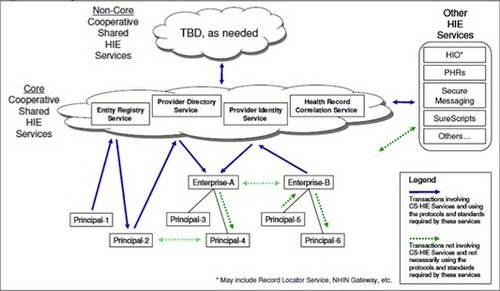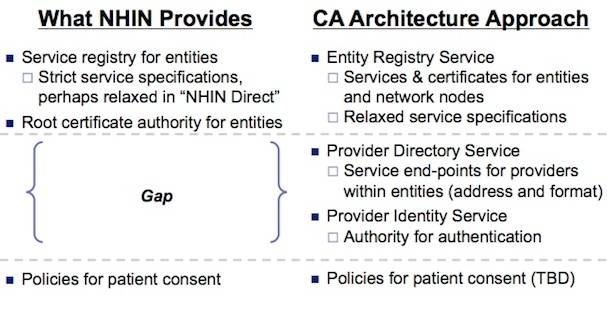Today, the California Health and Human Services convened a summit with an expected three hundred people in the interest of a state HIE (Health Information Exchange). This project has been tasked by volunteers and state groups and led by Jonah Frolich, deputy secretary of California Health and Human Services. The teams formed have met a series of hurdles already in preparation for the next big phase of executing the next generation system and raising an initial seed of $38.8m to move the effort forward.

At stake is at least $3 billion by connecting to these services for doctors and hospitals that qualify by using the HIE as built. This means that doctors can bill for more Medi-Cal and Medicare payments that are expected to be available in coming years from the American Recovery and Reinvestment Act funds while using HIE services. Additionally, the services being created will need to support applications that engage consumers as they play a role.
We see the opportunity for California’s investment to touch many interesting areas of cloud computing, identity management, and mobile – right as it is getting interesting.
Last week, Governor Arnold Schwarzenegger and California Health and Human Services Agency Secretary Kim Belshé named a new nonprofit entity called Cal eConnect to oversee the development of Health Information Exchange services. One of the first tasks at hand is to finish the CA HIE Operational plan and to finalize details in budget, technical, and engagement plans to execute with the recent first grant by ONC for $38.8m.

Today’s meeting and web conference is part of a process kicked off last July and offers monthly reports towards a state plan to direct funding for building a next generation model of HIE.
Leading up to this point, the CHHS efforts were led by Jonah Frohlich and comprised of many organizations and individuals contributing time to the effort to get the funding for the state. In addition to work group updates, the meeting included major parts of the organizations impacted the most, including quick fire discussion with CalPSAB’s Bobbie Holm, Medi-Cal’s Kim Ortiz, and for Public Health, Linette Scott.
Internet of Services, or, a Big Private Pub/Sub/Hub/Sub Cloud?
Shown here is the different core services that exist and how they provide links through HIE secure practices. And, how secondary services are build from there. This framework is focused on simplifying the overlay with existing services in a complex environment.
Here are some of the goals for the technical architecture:

- Provide a trust infrastructure for the electronic exchange of health information across organizations that have no pre-existing data-sharing arrangements
- Provide a directory infrastructure for providers to locate each other and to determine the format(s) that they mutually support for health information exchanges
- Assist organizations to match exchanged health information to the correct patient records
- Address gaps in the NHIN (Nationwide Health Information Network) specifications with respect to achieving HIE for meaningful use
Core, Context, and You
Determining what to offer and model the core services was a major part of the discussions in the technical work group.
One challenge the group faces in how to straddle this difficult issue is that identity and assertions for a person to live at the edge today, they are embedded in each application today in the form of passwords or tokens. Therefore, the CA HIE wants to be pragmatic in approach and have the first phases of architecture mirror the situation today.
At the same time, it was noted in the meeting today that the absence of a citizen registry is absent from the core services may be fatal. In this model, authorization, access, and consent is dealt with in the architectures as being “best effort” to integrate the patient data, but not “guaranteed”. This is due to the practical challenge that all the endpoints aren’t perfectly aligned in data, nor practices. And, that the HIE itself isn’t a panacea for identity on the Internet.
On high level, the question becomes: Is the HIE a services where citizens are registered “agents” and have a requirement to be joined directly to each message about themselves, or is there information about people in the system being exchanged is by agents? We think the more people are engaged the better and solving for this will lead to a citizen registry concept in the future.
Here we show the planned services, networks, registries and directories architecture view.

A New Network Forms Around Providers and Documents
The CA HIE project aligns with the work at the federal level with NHIN.
We got a briefing from Brian Behlendorf on the recent work from the NHIN Connect project. He gave some context of the base thinking going into the models.
The NHIN standards are, in a way, DNS (who has records for this patient? etc) and HTTP (transfer this data, securely) for health IT. Building as much as possible upon pre-existing components (SOAP standards, HL7, etc), using a document-exchange-oriented paradigm that matches the use cases closely. It encourages the use of information models for health IT, to make the data as computable as possible, but it does not require it. It is being used for needs as diverse as patient record search, public health reporting, and disability determinations. The trust model is the least well developed portion of it – every node on the network signs an agreement called the DURSA that sets a high bar for patient privacy, consent, auditing, and such – but it is agnostic to who a node is.
Shown here CA HIE is both a supporter of NHIN and also has several suggestions for modifying the scope to include a tighter link to Provider registries and communication practices, for the practical reasons of insuring end-to-end provider to provider communications.
This seems like a good balance where the state is more focused on the entities doing business and should have a tighter link with these entities and the business they conduct on HIE.

People: The Hardest Service
While moving forward with HIE for California, an important question is being raised. Do clouds consist information about citizens, or do they contain user identity services that join and connect individuals?
This is something that is somewhat hard to grasp, but we feel it will play a role in how the experience of HIE is for the person who is coming into the system. We’d like to see third party authorizations and trusted identity federation for citizens evolve and HIE seems liek the right backdrop to get it done. As reported earlier, third party logon can work, with the right incentives.
Jokingly, we ask ourselves will HIE work with RSS for all my provider feeds.
And with a more critical eye, we ask the same question. Shouldn’t all the services of HIE be using the best sharing technologies and patterns already in use? If I have a health concern, it seems that it should be as easy as “following” “Mike’s ashtma” to get every update from providers in a real time feed. It should be mash it up with other personal data, devices, and social forces.
We hope that the architecture gives extra consideration to the person, so they can do just as much, if not more, “mashing” of their own data streams.
We Worked Extra Hard to Weave in Lady Gaga
Celebrities, even ones not from California, are people with trials and tribulations too. In fact, in her recent video released today, “Telephone“, she addresses the access and issue of too much interruption and the benefits of both glamor and lifestyle.

She was spotted in California recently. The pictures of her hanging out at a SoCal mall reminded us that she is very much human.
Considering Gaga, we have added a few practical questions that the health cloud will need to manage as final food for thought.
- Will it work for traveling citizens and non-citizens alike that may have different records, languages, and locations.
- How will it enable care providers who manage children or elderly and will sign in and out of systems to pick up medications, for example.
- Does it work with mobile communications and social networks?
- Can it really offer true privacy for superstars, and everyday citizens with their health information? Is this even the right question?
We bet Jonah, the work groups, and the new team at Cal eConnect will be working hard to find answers.
Those answers may us to a next evolution. A health cloud – that powers the Internet at large.
Why does Health Information Exchange seem harder than colonizing Mars?










